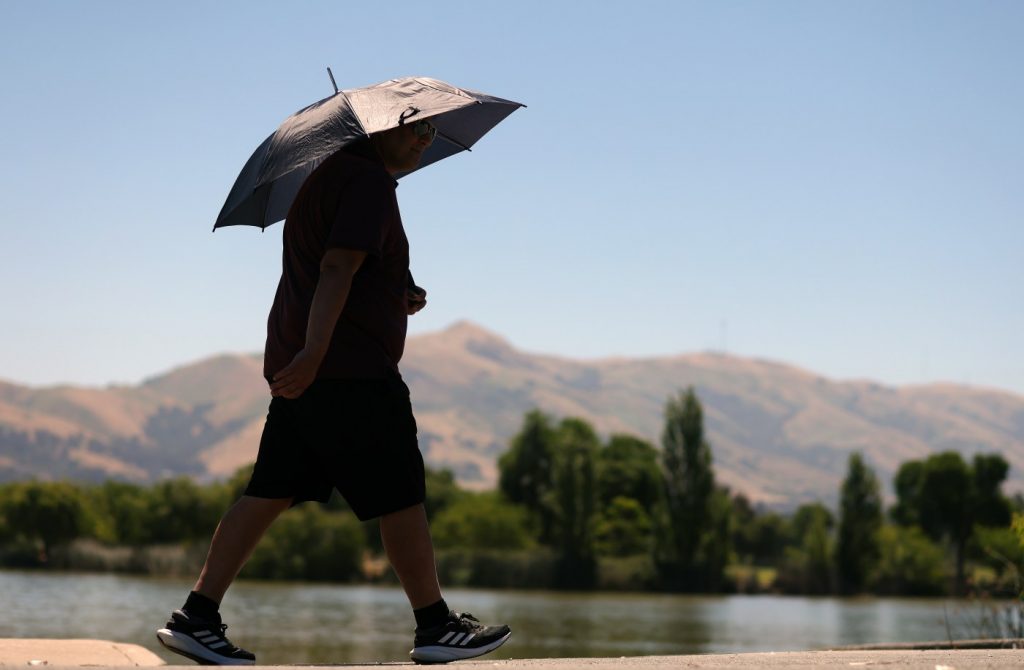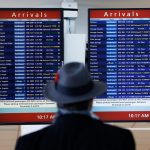All across the Bay Area Tuesday, sunglasses came out, sunscreen was spread, and air conditioners kicked on. It wasn’t quite hot enough for the old joke “I saw a bird pull a worm out of the ground with an oven mitt.” But in some places it felt like it.
“This is our first real taste of summer,” said Matt Mehle, a meteorologist with the National Weather Service in Monterey. “It’s hot. We’re not used to the heat yet.”
Summer doesn’t officially begin for another two weeks, on June 20.
Nevertheless, the warm surge pushed temperatures 10 to 15 degrees above normal in many communities, making Tuesday the hottest day of 2024 so far in the Bay Area, and the hottest since last October.
By 3 p.m., the hottest spot in the 9-county Bay Area was Vacaville, in Solano County, where the mercury hit 103 degrees. Not far behind were Santa Rosa with 100, Henry Coe State Park near Gilroy with 97 and Concord, also at 97. Temperatures in San Jose were somewhat balmier, hitting 89, while Oakland reached 84, and was San Francisco missed the heat entirely, with 73 degrees, with temperatures in all three cities expected to creep higher by late afternoon.
The heat should peak Wednesday, Mehle said, with a high of 98 forecast for Concord and Livermore, 95 expected in San Jose and Napa, 91 in Hollister, 82 in Oakland and 76 in San Francisco.
The National Weather Service issued a heat advisory for most of the Bay Area from Sonoma to Monterey counties through midnight Thursday, and urged people to drink plenty of fluids, take breaks in the shade if working outdoors, and make sure not to leave pets or children in vehicles.
Although hot, the Bay Area escaped the searing heat that was forecast to scorch other parts of California and the Southwest, as they baked under a “heat dome,” of high pressure air.
The National Weather Service issued an excessive heat warning for the Central Valley through Friday, with temperatures from 103 to 108 degrees forecast for in the San Joaquin Valley, Sacramento Valley and lower Sierra Nevada foothills. Hotter still was Death Valley, where 120 was possible, along with highs of 111 expected Thursday in Las Vegas and 112 in Phoenix.
Bay Area residents can thank the ocean for that.
“If you leave San Jose and drive through Gilroy into Los Banos, it will be up to 15 degrees hotter over the next few days,” said Jan Null, a meteorologist with Golden Gate Weather Services in Half Moon Bay? “Along our coast, the ocean is in the mid 50s and San Francisco bay waters are in the mid 60s. That influences the air. That’s our natural air conditioning. The farther inland you go the less of it there is.”
Null noted that Bay Area temperatures are expected to fall by Friday back to near-normal levels for June.
“It’s a good warmup but it will be short lived,” he said.
The hotter temperatures raised concerns about grass fires. The Corral Fire, which began Saturday in a rural area between Livermore and Tracy, and burned 14,000 acres, destroying one home, was 90% contained Tuesday.
“The heat increases fire risk,” said Capt. Chris Toler, with the Contra Costa County Fire Protection District. “High heat dries out vegetation, and makes it harder to fight fires when there is a structure fire. We’re hoping that our residents have done their due diligence with defensible space around their homes.”
Even though some heat waves have put strain on California’s power grid, this week’s shouldn’t, experts said Tuesday.
That’s because extreme heat is not affecting some parts of the state, such as Los Angeles, and because it will only last a couple of days.
“There are no alerts, no anything. It is completely business as usual,” said Severin Borenstein, a professor of business at UC Berkeley and vice chairman of the California Independent System Operator, which oversees the state power grid.
Borenstein noted that Tuesday, the peak electricity demand was forecast to be about 33,000 megawatts. The state had 47,000 megawatts of power available. The hottest demand of the year, during extreme heat waves late in the summer that last for a week or longer, spiking air conditioning use in millions of homes, is about 52,000 megawatts.
By mid-day Tuesday, solar power was generating 77% of California’s electricity. Because of several blackout scares in recent years during heat waves as solar power dropped as the sun began to set, state regulators have pushed utilities to boost the construction of large scale batteries, which now can store about 8,000 megawatts — up from nearly none five years ago — to use in the early evening, Borenstein noted.
“Things are looking good,” he said. “We are in the best position we have been in for at least three or four years.”
Across the Bay Area, people flocked to summer-like activities.
The line was 50 people long for the water slide at The Wave water park in Dublin.
“It’s very hot. There’s not a cloud in the sky. It’s sweltering,” said Lauren Schorah, who came to the water park with her two sons, Edward, 6, and Oliver, 9. “The kids have just finished school. We wanted a way to cool down and meet. Everybody had the same idea that we did!”
Lines were long at ice cream parlors as well.
“We’re packed. Ice cream is a great way to cool off,” said Anjan Parikh, owner of Sweet Retreat ice cream shop on Blossom Hill Road in San Jose. “The higher the temperate goes the better it is for business. It’s a one to one correlation.”
Angie Lomeli passed through Kelley Park in San Jose on her way to Happy Hollow Zoo with her 4-year-old grandson, Rico. She brings him to the zoo at least once a week, she said, and the heat did not deter her from today’s trip, even though the lemurs and other animals were laying low in the shade.
“He cannot be in the house too long without releasing some of his own heat,” Lomeli said of her grandson’s energy.
Rico sported shorts and a black t-shirt, while Lomeli also wore short sleeves. She also brought along a bottle of water.
“There’s plenty of shade in there,” she said, heading into the zoo.


